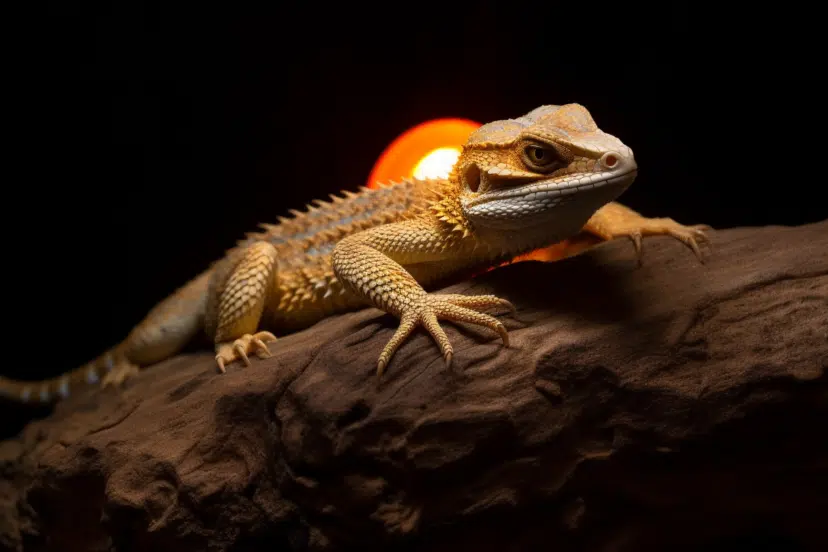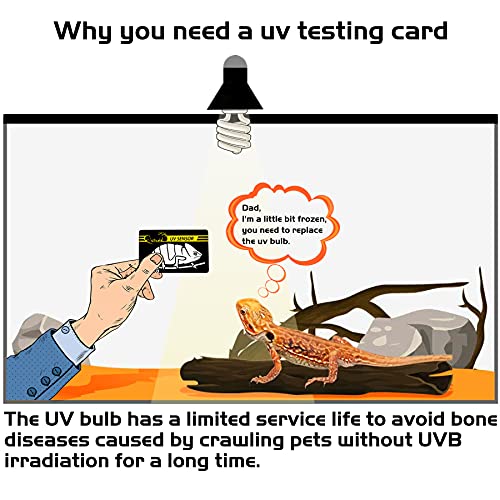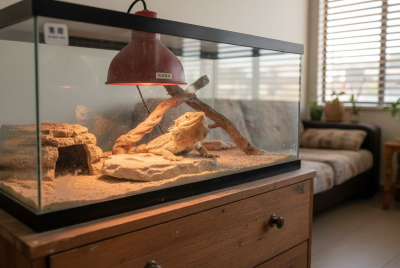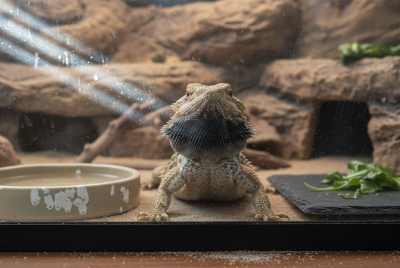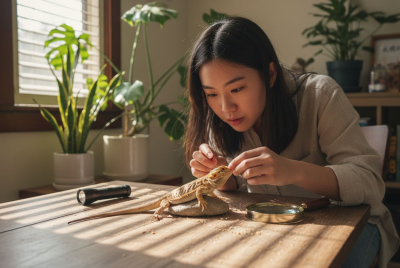Ferguson Zones for Bearded Dragons: A Comprehensive Guide
Understanding how to set up your bearded dragon’s environment properly is crucial to their health and longevity. One of the most essential components is ensuring they receive the correct amount of UVB light, which is where Ferguson Zones for bearded dragons come into play. In this guide, I’ll explain what Ferguson Zones are, why they matter, and how to ensure your bearded dragon gets the perfect amount of UVB for their well-being.
What Are Ferguson Zones?
Ferguson Zones are a scientific way to categorize the UVB exposure levels different reptiles need to thrive. These zones were created based on research conducted by Dr. Gary Ferguson, who studied the UV requirements of various reptiles in their natural environments. The zones range from 1 to 4, with each zone representing different levels of UV exposure that a reptile would experience in the wild.
Why Ferguson Zones Matter for Bearded Dragons
As desert dwellers, bearded dragons need proper exposure to UVB light to synthesize vitamin D3, which is crucial for their health. Without adequate UVB, they cannot properly metabolize calcium, leading to serious health issues like Metabolic Bone Disease (MBD). Understanding the Ferguson Zones ensures that your bearded dragon receives the right amount of UVB for optimal health.
Understanding UV Exposure and Its Importance
Bearded dragons, being native to the arid regions of Australia, naturally bask in the sun to get their needed UV exposure. In captivity, you need to replicate this natural behavior using UVB bulbs.
The Role of UVB for Bearded Dragons
UVB light plays a critical role in helping bearded dragons produce vitamin D3, which aids in calcium absorption. Without enough UVB, they can suffer from brittle bones and other health issues. On the flip side, too much UVB can cause eye damage and stress, which is why the right Ferguson Zone is essential.
Overview of Ferguson Zones
Let’s break down the Ferguson Zones and their specific UVB exposure levels to understand where bearded dragons fall on this scale.
Zone 1: Low UVB Exposure
This zone corresponds to reptiles that live in low UV environments, such as crepuscular or nocturnal species. They typically don’t require intense UVB lighting.
Zone 2: Moderate UVB Exposure
This zone is suitable for reptiles that live in more shaded environments or those that spend a significant portion of their time hiding. Many small lizards fall into this category.
Zone 3: High UVB Exposure
This is the sweet spot for bearded dragons. Reptiles in this zone thrive in environments with a higher UV index, similar to sunny, arid regions. This zone corresponds to reptiles that spend a lot of time basking in direct sunlight.
Zone 4: Very High UVB Exposure
This zone is for reptiles that live in extremely sunny environments with high UV exposure, such as species that live at high altitudes. These reptiles need the highest UVB levels.
The Ideal Ferguson Zone for Bearded Dragons
Bearded dragons fall into Ferguson Zone 3, which corresponds to high UVB exposure. In the wild, they spend many hours basking in direct sunlight, and your setup should mimic this behavior.
Why Zone 3 Is the Best Fit
Zone 3 provides the right balance of UVB intensity that matches the natural environment of bearded dragons. This level of UVB is essential for healthy bone development, strong immune function, and overall well-being.
Temperature and UVB Balance
Bearded dragons not only need UVB but also require the right temperatures in their enclosure to regulate their body functions. Aim for a basking temperature of 100-110°F, with cooler areas around 75-85°F. This balance ensures they can thermoregulate while getting their UVB exposure.
How to Measure UVB Levels in a Bearded Dragon’s Enclosure
To ensure you’re providing the right UVB levels, you’ll need some tools to measure the UV exposure in your bearded dragon’s enclosure.
Using a UV Index Meter
A UV Index meter is a helpful tool that lets you measure the UVB output directly where your dragon basks. For Zone 3, aim for a UV index between 3.0 and 7.0 in the basking spot. This ensures your dragon is getting enough UVB without overexposure.
Choosing the Right UVB Bulb
When selecting a UVB bulb, choose one that’s rated for high UV output, such as a 10.0 UVB bulb. Be sure to replace your bulb every 6-12 months as UVB output diminishes over time, even if the bulb is still emitting visible light.
Setting Up the Enclosure: Achieving the Right Ferguson Zone
Proper setup is key to ensuring your bearded dragon’s enclosure meets Ferguson Zone 3 requirements.
Placement of UVB Bulbs
Place the UVB bulb within 12-18 inches of your dragon’s basking spot for optimal exposure. If you have a mesh-top enclosure, make sure the mesh doesn’t block too much UVB from reaching the dragon.
Creating a Gradient for Basking
Your enclosure should offer a gradient of UVB exposure. This means the basking spot should have high UVB levels, but there should also be shaded areas with lower UV exposure where your dragon can retreat if they need a break from the light.
Maintaining Consistent UV Exposure
Consistency is key when it comes to UVB exposure. Use a timer to ensure your dragon gets 10-12 hours of UV light daily, mimicking natural daylight cycles.
Health Benefits of Proper UVB Exposure
Giving your bearded dragon the right amount of UVB exposure will provide numerous health benefits, helping them lead a long and healthy life.
Prevention of Metabolic Bone Disease
The most critical benefit of proper UVB exposure is preventing Metabolic Bone Disease (MBD). This disease occurs when dragons can’t absorb enough calcium, leading to weak and brittle bones. Adequate UVB lighting ensures they can produce the vitamin D3 needed to process calcium.
Enhanced Immune Function
UVB exposure has also been shown to boost the immune system in reptiles, making them more resistant to infections and illnesses. It helps maintain overall vitality and longevity in bearded dragons.
Common Mistakes in UVB Setup for Bearded Dragons
Unfortunately, many bearded dragon owners make mistakes when it comes to UVB setup. Let’s explore the common issues and how to avoid them.
Overexposure vs. Underexposure
Too much UVB can lead to eye damage and stress, while too little can result in MBD. It’s important to find the right balance and keep your UVB levels within the Ferguson Zone 3 range.
Incorrect Bulb Placement
One common mistake is placing the UVB bulb too far away from the basking spot or not measuring the UV output. Always double-check the bulb placement and ensure it’s within the recommended distance.
Conclusion: Achieving Optimal UVB Exposure Through Ferguson Zones
Ferguson Zones are a game-changer when it comes to understanding and meeting the UVB needs of your bearded dragon. By setting up the right lighting and enclosure based on Zone 3 requirements, you can help your bearded dragon thrive. Remember, proper UVB exposure prevents diseases and enhances their overall quality of life. With the right tools and knowledge, your dragon will live a long, healthy, and happy life.
FAQs
- What Ferguson Zone is ideal for bearded dragons?
Bearded dragons thrive in Ferguson Zone 3, which provides high UVB exposure, similar to their natural, sun-filled habitats. This zone ensures they receive the optimal UV levels needed for proper health and vitamin D3 synthesis. - How do I measure UVB levels in my bearded dragon’s tank?
You can measure UVB levels using a UV Index meter. For bearded dragons, aim for a UV index between 3.0 and 7.0 at the basking spot to match Ferguson Zone 3 requirements. - How often should I replace my UVB bulb?
Even if your UVB bulb is still emitting light, it needs to be replaced every 6-12 months as the UVB output diminishes over time, affecting its ability to support your dragon’s health. - Can I use a UVB bulb with a higher output to improve my dragon’s health?
No, overexposing your bearded dragon to excessive UVB (outside of Ferguson Zone 3 levels) can cause eye damage and stress. Stick to the recommended UV index range for their health and well-being. - What happens if my bearded dragon doesn’t get enough UVB?
Without enough UVB, your bearded dragon may develop Metabolic Bone Disease (MBD), which leads to brittle bones and other health complications. Proper UVB exposure is essential for their calcium absorption and overall vitality.
By understanding and properly implementing the Ferguson Zones, especially Zone 3, you can ensure your bearded dragon has the right UVB environment for optimal health. Regular monitoring and adjustments to your enclosure’s lighting setup will help your dragon thrive and live a long, healthy life!

